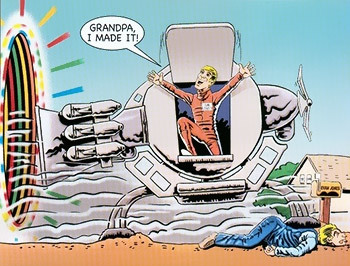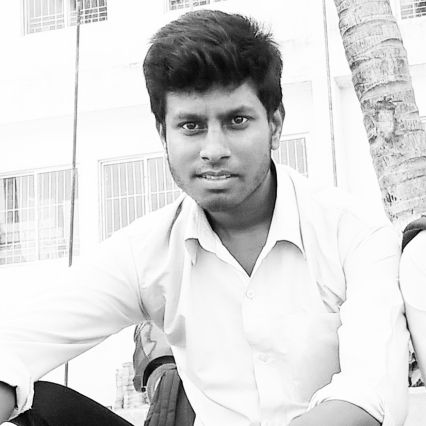What would happen to you if you went back in time and killed your grandfather? A model using photons reveals that quantum mechanics can solve the quandary—and even foil quantum cryptography

Tim hates Grandfather. Tim hates him so much that his ambition is to murder Grandfather despite the fact that Grandfather is already dead: he died in his sleep in 1957. Tim is no quitter, however, so he builds a time machine and travels back to the year 1920, a time before Grandfather’s death. Tim buys a high-powered rifle, practices his marksmanship for many days, rents a room along the path Grandfather takes to work every day, and waits for optimal conditions. When the time is right, Tim locks and barricades the door to avoid any intrusion, and otherwise prevents any factors that might keep him from hitting his target. Tim is perfectly accurate when shooting any practical distance. As Grandfather walks by the room, he is only twenty yards away.
It seems that Tim can kill Grandfather. Every condition is optimal for a perfect shot that would kill him instantly. There is, however, the outstanding fact that Grandfather dies in his bed in 1957. It cannot be that both Tim murders Grandfather in 1921 and Grandfather dies of natural causes in 1957. Since we know Grandfather dies in his sleep in 1957, then it must be the case that Tim does not kill Grandfather in 1921. Now, it seems that Tim can’t kill Grandfather.
This presents us with what looks like a contradiction. According to the conclusions of Arguments A and B listed above, Tim can kill Grandfather and Tim can’t kill Grandfather. So which is it? Can he or not? Here are three ways out.

ARGUMENT A: Tim Can’t Kill Grandfather
One tempting option is to object to Argument A. Logic being what it is, the universe will not allow a contradiction to be created.
Grandfather didn’t die in 1921; he didn’t die until 1957 and even then died of natural causes. So, if Tim were to try to kill Grandfather, he would fail. Tim might lose his nerve, or it is possible that the rifle will not go off when he fires it, or even after all of his practicing, Tim will fire a shot and miss. Tim cannot kill his grandfather. Time travelers “can’t change any past fact whatsoever” (Le Poidevin 2005, 179).
ARGUMENT B:Tim Can Kill Grandfather
A second approach attempts to show that Argument B is unsound. The challenge is to the second premise of this argument: It doesn’t follow from the fact that Tim doesn’t kill Grandfather that Tim can’t kill Grandfather. There are lots of things that we don’t do but that we could have done. This approach is defended by Paul Horwich (1975).
A little elementary modal logic is sometimes invoked to explain why the second premise of Argument B can seem true. Using a wide-scope reading, the second premise says that, necessarily, (if Tim didn’t kill Grandfather, then Tim doesn’t kill Grandfather). While this is true, when inserted back into the argument, the argument becomes invalid. Using a narrow-scope reading, the second premise says that if Tim didn’t kill Grandfather, then, necessarily, (Tim doesn’t kill Grandfather). This results in a valid argument, but, on this reading, the premise is false. According to this premise, on the narrow-scope reading, Tim’s not killing Grandfather implies that, necessarily, Tim does not kill him, which is not true. There are other possible worlds in which Grandfather didn’t die in 1957, instead Tim kills him in 1921. Just because Tim didn’t, doesn’t mean he can’t.
Context Dependence
Another approach to the paradox comes from David Lewis (1976). He argues that the word ‘can’ is context dependent. This means that a sentence including the word ‘can’ may be true in some contexts and false in others. “To say that something can happen means that its happening is compossible with certain facts” (p. 150). He believes that ‘x can do y’ is true in context C if and only if x’s doing y is consistent with certain facts picked out by C. Lewis does not elaborate about what he believes these “certain facts” are, but John Carroll (2010) suggests that these facts are the common ground of the context, the presumed to be shared information, the presuppositions and suppositions.
Depending on the context, either Argument A or Argument B will be unsound. In contexts where it is supposed that Grandfather died in 1957 of natural causes, Argument A will turn out unsound because ‘Tim can’t kill Grandfather’ is true and therefore ‘Tim can kill Grandfather’ is false; Premise 2 Argument A is false for these contexts. In contexts where we don’t suppose or presuppose any post-1920 information about Grandfather or Tim, then Argument B will be unsound because ‘Tim can kill Grandfather’ is true and ‘Tim can’t kill Grandfather’ is false; so Premise 2 of Argument B is false for these contexts. What it is true to say Tim is able to do relative to one set of facts, he is not able to do relative to another. To get a contradiction, both arguments would have to be sound in the same context. In the absence of such a context, The Grandfather Paradox is not a significant challenge to the possibility of time travel.
Conclusions
Each of the three resolutions to The Grandfather Paradox seems plausible and yet very different from the other two. The second resolution finds fault with Argument B. This is very different from the first resolution, which finds fault with Argument A. Lewis shows why these two resolutions can both seem appealing, and he also agrees that ultimately there is no genuine contradiction. The only difference is that, with his approach, where the fault lies depends on context.
Time Travel Simulation Resolves “Grandfather Paradox”
On June 28, 2009, the world-famous physicist Stephen Hawking threw a party at the University of Cambridge, complete with balloons, hors d'oeuvres and iced champagne. Everyone was invited but no one showed up. Hawking had expected as much, because he only sent out invitations after his party had concluded. It was, he said, "a welcome reception for future time travelers," a tongue-in-cheek experiment to reinforce his 1992 conjecture that travel into the past is effectively impossible.
But Hawking may be on the wrong side of history. Recent experiments offer tentative support for time travel's feasibility—at least from a mathematical perspective. The study cuts to the core of our understanding of the universe, and the resolution of the possibility of time travel, far from being a topic worthy only of science fiction, would have profound implications for fundamental physics as well as for practical applications such as quantum cryptography and computing.

Closed timelike curves
The source of time travel speculation lies in the fact that our best physical theories seem to contain no prohibitions on traveling backward through time. The feat should be possible based on Einstein's theory of general relativity, which describes gravity as the warping of spacetime by energy and matter. An extremely powerful gravitational field, such as that produced by a spinning black hole, could in principle profoundly warp the fabric of existence so that spacetime bends back on itself. This would create a "closed timelike curve," or CTC, a loop that could be traversed to travel back in time.
Hawking and many other physicists find CTCs abhorrent, because any macroscopic object traveling through one would inevitably create paradoxes where cause and effect break down. In a model proposed by the theorist David Deutsch in 1991, however, the paradoxes created by CTCs could be avoided at the quantum scale because of the behavior of fundamental particles, which follow only the fuzzy rules of probability rather than strict determinism. "It's intriguing that you've got general relativity predicting these paradoxes, but then you consider them in quantum mechanical terms and the paradoxes go away," says University of Queensland physicist Tim Ralph. "It makes you wonder whether this is important in terms of formulating a theory that unifies general relativity with quantum mechanics."
Experimenting with a curve
Recently Ralph and his PhD student Martin Ringbauer led a team that experimentally simulated Deutsch's model of CTCs for the very first time, testing and confirming many aspects of the two-decades-old theory. Their findings are published in Nature Communications. Much of their simulation revolved around investigating how Deutsch's model deals with the “grandfather paradox,” a hypothetical scenario in which someone uses a CTC to travel back through time to murder her own grandfather, thus preventing her own later birth.
Deutsch's quantum solution to the grandfather paradox works something like this:
Instead of a human being traversing a CTC to kill her ancestor, imagine that a fundamental particle goes back in time to flip a switch on the particle-generating machine that created it. If the particle flips the switch, the machine emits a particle—the particle—back into the CTC; if the switch isn't flipped, the machine emits nothing. In this scenario there is no a priori deterministic certainty to the particle's emission, only a distribution of probabilities. Deutsch's insight was to postulate self-consistency in the quantum realm, to insist that any particle entering one end of a CTC must emerge at the other end with identical properties. Therefore, a particle emitted by the machine with a probability of one half would enter the CTC and come out the other end to flip the switch with a probability of one half, imbuing itself at birth with a probability of one half of going back to flip the switch. If the particle were a person, she would be born with a one-half probability of killing her grandfather, giving her grandfather a one-half probability of escaping death at her hands—good enough in probabilistic terms to close the causative loop and escape the paradox. Strange though it may be, this solution is in keeping with the known laws of quantum mechanics.
In their new simulation Ralph, Ringbauer and their colleagues studied Deutsch's model using interactions between pairs of polarized photons within a quantum system that they argue is mathematically equivalent to a single photon traversing a CTC. "We encode their polarization so that the second one acts as kind of a past incarnation of the first,” Ringbauer says. So instead of sending a person through a time loop, they created a stunt double of the person and ran him through a time-loop simulator to see if the doppelganger emerging from a CTC exactly resembled the original person as he was in that moment in the past. By measuring the polarization states of the second photon after its interaction with the first, across multiple trials the team successfully demonstrated Deutsch's self-consistency in action. "The state we got at our output, the second photon at the simulated exit of the CTC, was the same as that of our input, the first encoded photon at the CTC entrance," Ralph says. "Of course, we're not really sending anything back in time but [the simulation] allows us to study weird evolutions normally not allowed in quantum mechanics."
Those "weird evolutions" enabled by a CTC, Ringbauer notes, would have remarkable practical applications, such as breaking quantum-based cryptography through the cloning of the quantum states of fundamental particles. "If you can clone quantum states,” he says, “you can violate the Heisenberg uncertainty principle,” which comes in handy in quantum cryptography because the principle forbids simultaneously accurate measurements of certain kinds of paired variables, such as position and momentum. "But if you clone that system, you can measure one quantity in the first and the other quantity in the second, allowing you to decrypt an encoded message."
"In the presence of CTCs, quantum mechanics allows one to perform very powerful information-processing tasks, much more than we believe classical or even normal quantum computers could do," says Todd Brun, a physicist at the University of Southern California who was not involved with the team's experiment. "If the Deutsch model is correct, then this experiment faithfully simulates what could be done with an actual CTC. But this experiment cannot test the Deutsch model itself; that could only be done with access to an actual CTC."
Alternative reasoning
Deutsch's model isn’t the only one around, however. In 2009 Seth Lloyd, a theorist at Massachusetts Institute of Technology, proposed an alternative, less radical model of CTCs that resolves the grandfather paradox using quantum teleportation and a technique called post-selection, rather than Deutsch's quantum self-consistency. With Canadian collaborators, Lloyd went on to perform successful laboratory simulations of his model in 2011. "Deutsch's theory has a weird effect of destroying correlations," Lloyd says. "That is, a time traveler who emerges from a Deutschian CTC enters a universe that has nothing to do with the one she exited in the future. By contrast, post-selected CTCs preserve correlations, so that the time traveler returns to the same universe that she remembers in the past."
This property of Lloyd's model would make CTCs much less powerful for information processing, although still far superior to what computers could achieve in typical regions of spacetime. "The classes of problems our CTCs could help solve are roughly equivalent to finding needles in haystacks," Lloyd says. "But a computer in a Deutschian CTC could solve why haystacks exist in the first place.”
Lloyd, though, readily admits the speculative nature of CTCs. “I have no idea which model is really right. Probably both of them are wrong,” he says. Of course, he adds, the other possibility is that Hawking is correct, “that CTCs simply don't and cannot exist." Time-travel party planners should save the champagne for themselves—their hoped-for future guests seem unlikely to arrive
The above information is collected from around the internet but very soon, I will post my own Time Machine theory
UNDER MAINTENANCE











<a href="http://eurotousd.info/">Euro to Dollar</a>
http://august2018calendar.info
http://march2018calendar.info/
http://may2018calendar.info/
http://upstrack.info/
http://faxcoversheet.info/
http://february2018calendar.info/
http://printablecalendar2018.info
http://kingrootapk.net/
http://xmodgamesdownload.co
http://xmodgamesdownload.co/ios-iphone/